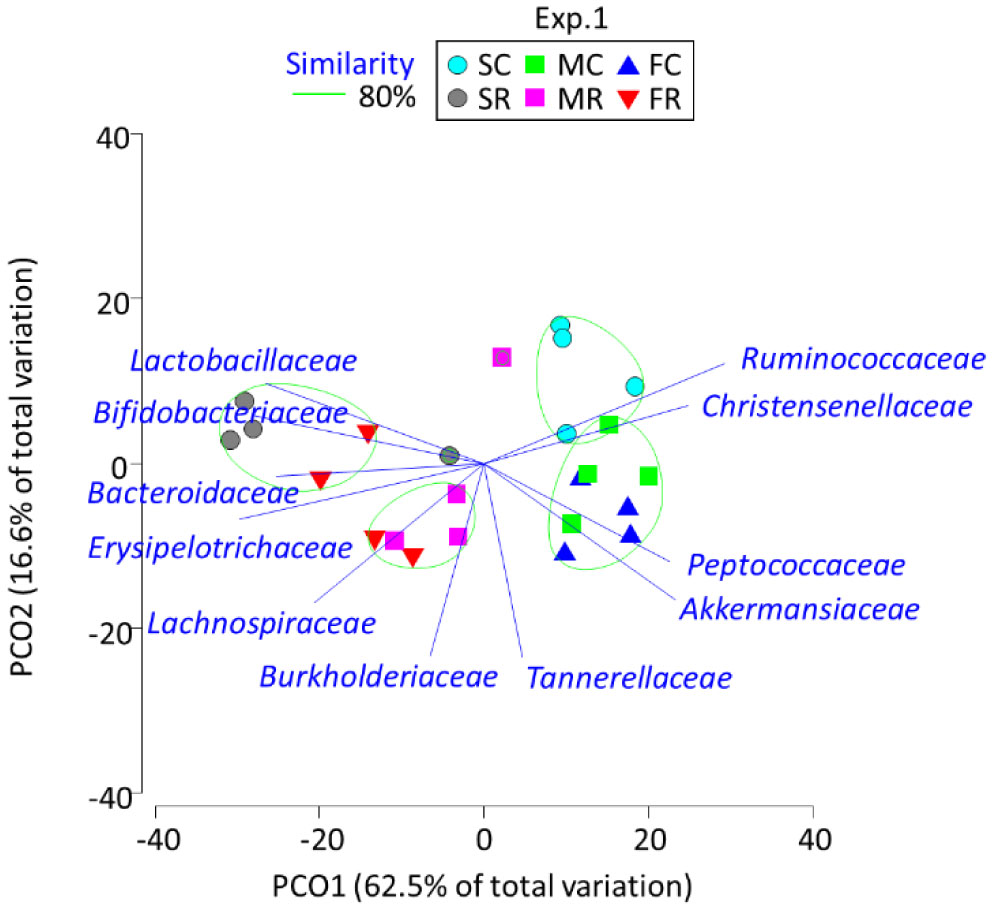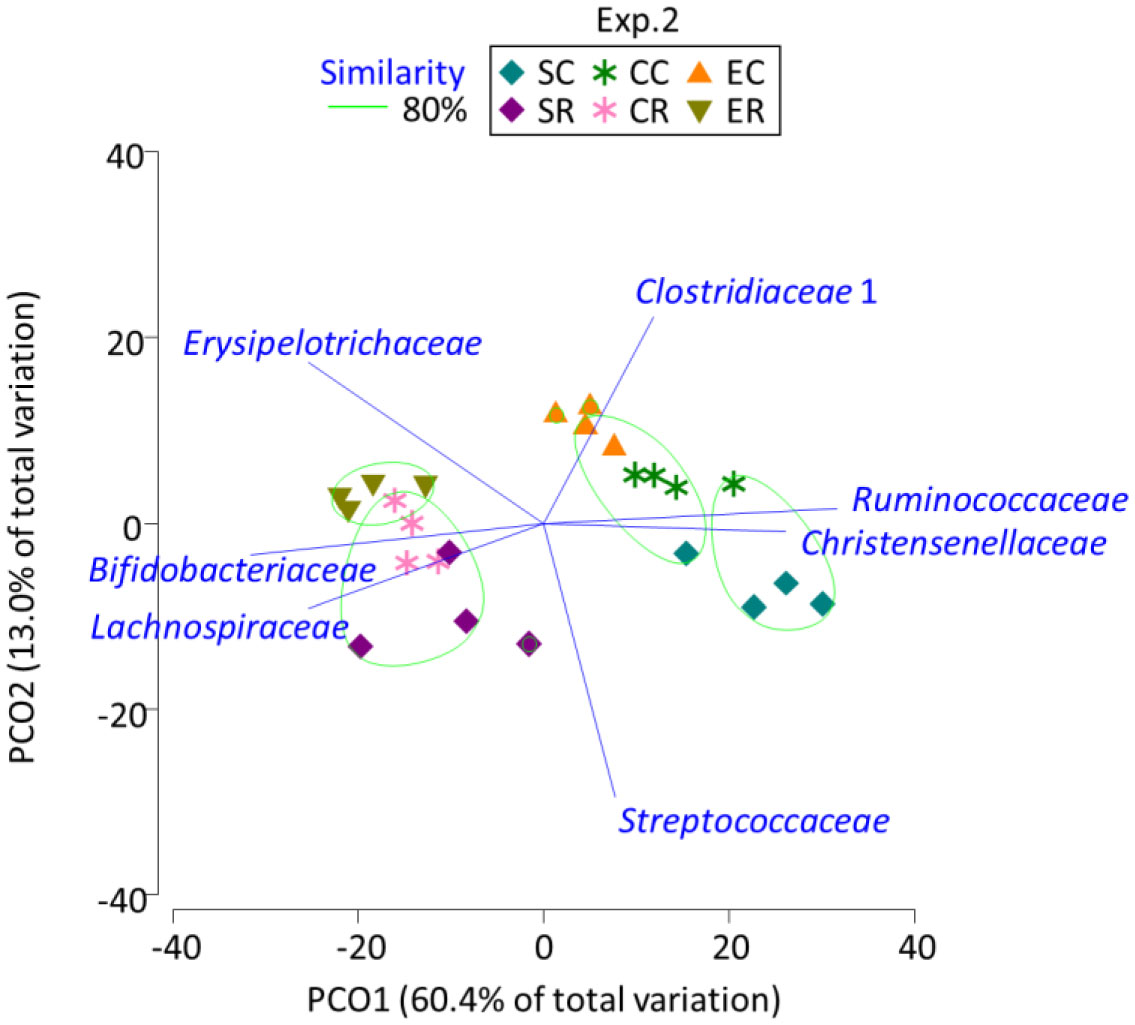Diet is considered the most influential factor in modulating the gut microbiota but how dietary protein sources differ in their modulatory effects is not well understood. In this study, soy, meat (mixture of beef and pork), and fish proteins (experiment 1) and soy, milk (casein), and egg proteins (experiment 2) were fed to rats with cellulose (CEL) and raffinose (RAF); the microbiota composition and short-chain fatty acid concentration in the cecum were determined. Egg protein feeding decreased the concentration of acetic acid and the richness and diversity of the cecum microbiota. RAF feeding increased the concentrations of acetic and propionic acids and decreased the richness and diversity of the cecum microbiota. When fed with CEL, the abundance of Ruminococcaceae and Christensenellaceae, Akkermansiaceae and Tannerellaceae, and Erysipelotrichaceae enhanced with soy protein, meat and fish proteins, and egg protein, respectively. The effects of dietary proteins diminished with RAF feeding and the abundance of Bifidobacteriaceae, Erysipelotrichaceae, and Lachnospiraceae increased and that of Ruminococcaceae and Christensenellaceae decreased regardless of the protein source. These results indicate that, although the effect of prebiotics is more robust and distinctive, dietary protein sources may influence the composition and metabolic activities of the gut microbiota. The stimulatory effects of soy, meat, and egg proteins on Christensenellaceae, Akkermansiaceae, and Erysipelotrichaceae deserve further examination to better elucidate the dietary manipulation of the gut microbiota.
1.
Introduction
In this paper we study the following time-fractional telegraph equation (TFTE) [1,2,3]
where 1<γ<2, a,b,c and T are given positive constants, f(x,t),ϕ1(x),ϕ2(x),ψ1(t) and ψ2(t) are given functions and satisfy the compatibility conditions, DγC,tu(x,t) and Dγ−1C,tu(x,t) are the Caputo fractional derivatives of order γ and γ−1 respectively. The Caputo fractional derivative DγC,tu(x,t) is defined by [4,Definition 2.2]
The Caputo operators DγC,t and Dγ−1C,t have the following relationship
Based on the above relationship, the TFTE (1.1) can be transformed into the following equivalent integral-differential equation as shown in [4,Lemma 6.2]
which simplifies the original problem to a certain extent. For the subsequent numerical discretization and error analysis, we assume
The TFTE (1.1) is used to describe some phenomena such as propagation of electric signals [5], acoustic waves in porous media [6], transport of neutron in a nuclear reactor [7], and hyperbolic heat transfer [8].
There are a few numerical methods to solve the TFTE. Wang [9] developed a method in the reproducing kernel space by piecewise technique to solve the TFTE. Hosseini et al. [10] applied the radial basis functions and finite difference method to solve the TFTE. Kumar et al. [11] described a finite difference scheme for the generalized TFTE. Hashemi and Baleanu [12] utilized a combination of method of line and group preserving scheme to solve the TFTE. Wei et al. [13] discussed a fully discrete local discontinuous Galerkin finite element method for the TFTE. Sweilam [14] introduced the Sinc-Legendre collocation method for solving the TFTE. Mollahasani et al. [15] presented an operational method based on hybrid functions of Legendre polynomials and Block-Pulse-Functions for solving the TFTE. Hafez and Youssri [16] used a shifted Jacobi collocation scheme for a multidimensional TFTE. Bhrawy et al. [17] proposed an accurate and efficient spectral algorithm for the numerical solution of the two-sided space-time TFTE with three types of non-homogeneous boundary conditions. Youssri et al. [18,19] also developed numerical spectral Legendre approaches to solve the TFTEs. Bhrawy and Zaky [20] used a method based on the Jacobi tau approximation for solving multi-term time-space TFTE. In [2,3] B-spline collocation methods were applied to solve the TFTEs. In [21,22] wavelet methods were used to solve the TFTEs. But these papers only study the case that the solutions of the TFTEs are sufficiently smooth. Special treatment techniques, such as graded meshes [23,24,25,26,27] and mapped basis functions [28] reflecting the characteristics of the singularity of the exact solution, need to be used to solve the fractional differential equations.
The aim of the present study is twofold. The first aim is to construct an integral-difference discretization scheme on a graded mesh to approximate the integral-differential equation with a weakly singular kernel transformed from the TFTE, which is a second-order convergence discretization scheme. The second aim is to take the possible singularity of the exact solution into account in the convergence analysis, where the singularity of the exact solution is reflected as
which can be referred in the literature [25,26,27,29] for details. We show that our discretization scheme on a graded mesh is second-order convergent for both the spatial discretization and the time discretization, although the exact solution of the TFTE may have singularity. Numerical experiments confirm the effectiveness of the theoretical results, and also verify that this scheme is more accurate than the methods given in [2,3].
Remark 1.1 If b,c are variable coefficients and a is a variable coefficient with respect to x, the TFTE (1.1) can also be transformed into the same integral-differential equation as given in (1.2). If a is a variable coefficient with respect to t, we first approximate a with a piecewise linear interpolation function about t and then transform the approximate TFTE into an integral-differential equation as given in (1.2). If there is a nonlinear term in the TFTE, we first transform it into a linear equation by Newton iterative method and then transform it into an integral-differential equation as given in (1.2).
Notation. Throughout the paper, C is used to indicate the positive constant independent of the mesh, and C in different places can represent different values. In order to simplify the notation, the representation gji=g(xi,tj) is introduced for any function g at the mesh point (xi,tj)∈(0,1)×(0,T].
2.
Discretization scheme
We developed the discretization scheme on a graded mesh ˉΩN,K≡{(xi,tj)|xi=ih,h=1/N,0≤i≤ N,0≤j≤K} with time mesh points
and time sizes △tj=tj−tj−1 for 1≤j≤K, where the discretization parameters N and K are positive integers. The following integral-difference discretization scheme
for 1≤i<N and 1≤j≤K is used to approximate the integral-differential equation in (1.2), where Uji denotes the numerical solution at the mesh point (xi,tj) and δ2xUji=Uji+1−2Uji+Uji−1h2. Thus, our discretization scheme for problem (1.2) is
where
Let zji=Uji−uji for 0≤i≤N and 0≤j≤K. Then, from (1.2) and (2.2) we know that the error mesh function z satisfies
where
Then, under the assumption (1.3) we can obtain
where we have used the linear interpolation remainder formula
the regularities (1.4) and (1.5), the assumption (1.3), the graded mesh (2.1), the inequality (see [30])
for α<0, and the following estimates
The following lemma gives a useful result for our convergence analysis, which is given in [31].
Lemma 2.1 Assume that {ωk}∞k=0 be a sequence of non-negative real numbers satisfying
Then for any integer K>0 and vector (V1,V2,…,VK)T∈RK, the following inequality
holds true.
Next we show that the sequence {βj,k}jk=1 satisfies the conditions in Lemma 2.1 by using the technique in [32], where βj,j−k=△tj(ξj,k+1+ηj,k) with ξj,j+1=0.
Lemma 2.2 The sequence {βj,k}jk=0 satisfies
Proof. From the definitions of the sequences {ξj,k}jk=1 and {ηj,k}jk=1 we have
for 1≤k<j and
where
Obviously, from (2.7) and (2.8) we have
and
Since
we can obtain
which imply
From (2.9)–(2.11) we know the lemma holds true.
A modified Grönwall inequality given in [33,Lemma 3.3] also is needed in the convergence analysis of the scheme.
Lemma 2.3 Suppose that α,C0,T>0 and dk,j=C0△tk+1(tj−tk)α−1(k=0,1,…,j−1) for 0=t0<t1<⋯<tK=T and j=1,2,…,K, where △tk+1=tk+1−tk. Assume that g0 is positive and the sequence {φj} satisfies
then
For analyzing the stability and estimating the error for the discrete scheme (2.2) we introduce the discrete inner product and discrete L2-norm ‖⋅‖ as follows
where v and w are two mesh functions. We also introduce the notation δxvi=vi−vi−1h for 1≤i≤N.
By using the technique given in [34,Theorem 3.2] we will derive the following stability result of the discrete scheme (2.2).
Theorem 2.4 Let {Uji|0≤i≤N, 1≤j≤K} be the solution of the discrete scheme (2.2). Then the numerical solution U satisfies the following estimates
where C is a positive constant independent of N and K.
Proof. First we rewrite (2.2) as the following equation
for 1≤i<N and 1≤j≤K. Then, taking the inner produce of (2.12) with Uji, we can get
By recursion, we also can get the following equations
Applying the inequality
and the equality
we have
Adding up the above inequalities we can obtain
where we have used Lemmas 2.1 and 2.2. From the above inequality we have
where ξj−1,j=0. For each j, there exists j∗(1≤j∗≤j) such that
Since j in (2.13) is any integer from 0 to N, we have
Combining the above inequality with Lemma 2.2 we have
for 1≤j∗≤j≤K. Furthermore, we have
where we have used the mean value theorem with θk∈(tk−1,tk) and the inequality n≤2(n−1) for n≥2. Combining (2.14) and (2.15) we can get
for 1≤j≤K, where Lemma 2.3 has been used. This inequality implies the theorem holds true.
Next we derive the error estimates for the integral-difference discretization scheme (2.2).
Theorem 2.5 Under the regularity conditions (1.4) and (1.5) and the assumption (1.3), we have the following error estimates
where C is a positive constant independent of N and K.
Proof. Applying Theorem 2.4 to the error equation (2.5) we can derive
where we have used the estimates (2.6). From this we complete the proof.
3.
Numerical experiments
In this section we present some numerical results to indicate experimentally the efficiency and accuracy of the integral-difference discretization scheme. Errors and convergence rates for the integral-difference discretization scheme are presented for two examples.
Example 4.1 We first consider the TFTE (1.1) with a=b=1,c=π,ϕ1(x)=ϕ2(x)=ψ1(t)=0 and ψ2(t)=t3sin2(1), where f(x,t) is chosen such that the exact solution is u(x,t)=t3sin2(x). This equation has been tested in [2,3].
We measure the accuracy in the discrete L2-norm and L∞-norm
and the convergence rate
respectively. In order to further confirm that the convergence rate in the time direction is consistent with the theoretical convergence rate, we also measure the convergence rates by fixing a large N as follows
respectively. The numerical results for Example 4.1 are tabulated in Tables 1 and 2.
Example 4.2 We now consider the TFTE (1.1) with a=b=c=1,ϕ1(x)=ϕ2(x)=0, ψ1(t)=ψ2(t)=tγ, where f(x,t) is chosen such that the exact solution is u(x,t)=tγ(x2−x+1). We also measure the accuracy in the discrete L2-norm eN,KL2, L∞-norm eN,KL∞ and the convergence rates rN,KL2,rN,KL∞,ˉrN,KL2,ˉrN,KL∞ as previously defined, respectively. The numerical results for Example 4.2 are tabulated in Tables 3 and 4.
Tables 1–4 show that the numerical solution of the integral-difference discretization scheme on a graded mesh converges to the exact solution with second-order accuracy for both the spatial discretization and the time discretization in the discrete L2-norm and in the discrete L∞-norm, respectively. Moreover, compared with the previous methods with only first-order convergence for the time discretization, our discretization scheme improves the previous results given in [2,3].
4.
Conclusions and discussion
In this paper, the TFTE is transformed into an equivalent integral-differential equation with a weakly singular kernel by using the integral transformation. Then an integral-difference discretization scheme on a graded mesh is developed to approximate the integral-differential equation. The stability and convergence are proved by using the L2-norm. The possible singularity of the exact solution is taken into account in the convergence analysis. It is shown that the scheme is second-order convergent for both the spatial discretization and the time discretization. The numerical experiments demonstrate the validity of our theoretical results and also verify that this scheme is more accurate than the methods given in [2,3]. In future we will extend this method to variable-order fractional differential equations.
Acknowledgments
We would like to thank the anonymous reviewers for their valuable suggestions and comments for the improvement of this paper. The authors declare that there is no conflict of interests regarding the publication of this article. The work was supported by Ningbo Municipal Natural Science Foundation (Grant Nos. 2021J178, 2021J179) and Zhejiang Province Public Welfare Technology Application Research Project (Grant No. LGF22H260003).
Conflict of interest
The authors declare there is no conflict of interest.









 DownLoad:
DownLoad:





